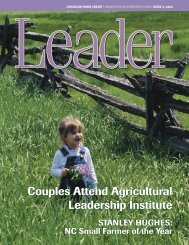2011 Annual Report - Carolina Farm Credit
2011 Annual Report - Carolina Farm Credit
2011 Annual Report - Carolina Farm Credit
You also want an ePaper? Increase the reach of your titles
YUMPU automatically turns print PDFs into web optimized ePapers that Google loves.
<strong>Carolina</strong> <strong>Farm</strong> <strong>Credit</strong>, ACA<br />
The February 2012 USDA forecast estimates <strong>2011</strong> farmers’ net<br />
cash income, which is a measure of the cash income after<br />
payment of business expenses, increased to $108.7 billion, up<br />
$16.4 billion from 2010 and up $28.4 billion from its 10-year<br />
average of $80.3 billion. The improvement in <strong>2011</strong> farmers’ net<br />
cash income was due primarily to increases in crop receipts of<br />
$24.0 billion and livestock receipts of $24.6 billion, partially<br />
offset by a $34.7 billion increase in cash expenses.<br />
The February 2012 USDA forecast for the farm economy, as a<br />
whole, projects 2012 farmers’ net cash income to decrease to<br />
$96.3 billion, a $12.4 billion decrease from <strong>2011</strong>, but $16.0<br />
billion above the 10-year average. The forecasted decrease in<br />
farmers’ net cash income for 2012 is primarily due to an<br />
expected increase in cash expenses of $11.3 billion, while crop<br />
and livestock receipts remain near the <strong>2011</strong> levels.<br />
For 2012, the USDA expects crop receipts to increase slightly,<br />
as increases in corn and most other feed grains offset declines in<br />
wheat, hay, vegetables/melons, and fruits/tree nuts. The drought<br />
in parts of the U.S. in <strong>2011</strong> is expected to depress sales of many<br />
crops through its negative impact on production. Livestock<br />
receipts are expected to decline marginally in 2012. While<br />
receipts for cattle are anticipated to increase as demand for beef<br />
in the Asian markets remains strong, dairy receipts are expected<br />
to decrease as milk prices are forecast to be lower.<br />
The following table sets forth the commodity prices per bushel<br />
for certain crops and by hundredweight for beef cattle from<br />
December 31, 2008 to December 31, <strong>2011</strong>:<br />
Commodity 12/31/11 12/31/10 12/31/09 12/31/08<br />
Corn $5.86 $4.82 $3.60 $4.11<br />
Soybeans $11.50 $11.60 $9.80 $9.24<br />
Wheat $7.19 $6.45 $4.87 $5.95<br />
Beef Cattle $120.00 $98.10 $78.50 $79.70<br />
approximately 90 percent of farm household income for<br />
intermediate farms is generated from off-farm sources. Further,<br />
USDA data suggests that approximately 24 percent of farm<br />
household income for commercial farms is generated from offfarm<br />
income.<br />
According to the USDA’s February 2012 forecast, farm sector<br />
asset values and farm debt are forecasted to rise modestly in<br />
2012. <strong>Farm</strong> sector asset values are expected to rise 5.6 percent<br />
from $2.34 trillion for <strong>2011</strong> to $2.47 trillion in 2012 primarily<br />
due to an increase in the value of farm real estate. The values of<br />
machinery/equipment, purchased inputs and financial assets are<br />
expected to rise modestly in 2012, while the value of livestock<br />
and poultry inventories is expected to decline slightly. The<br />
main factors driving higher farmland values are the continued<br />
strength of commodity prices, low interest rates, expectations of<br />
continued favorable net returns and growth in agricultural<br />
exports. <strong>Farm</strong>er’s equity (farm business assets minus debt) is<br />
expected to rise 5.7 percent from $2.10 trillion in <strong>2011</strong> to $2.22<br />
trillion in 2012.<br />
One measure of the financial health of the agricultural sector<br />
used by the USDA is the assessment of farmers’ utilization of<br />
their capacity to repay debt (actual debt as a percentage of<br />
maximum debt that can be supported by farmers’ current<br />
income). Higher capacity utilization rates indicate tighter cash<br />
flow positions and, consequently, higher exposure to financial<br />
risk. Lower rates indicate healthier cash flow and financial<br />
positions. These estimates do not take into account, however,<br />
off-farm income sources. Since 1970, debt repayment capacity<br />
utilization has ranged from a low of 37 percent in 1973 to a high<br />
of 110 percent in 1981, and has remained relatively stable since<br />
1987, averaging about 50 percent. The forecast for 2012<br />
predicts farmers’ utilization to increase from 40 percent in <strong>2011</strong><br />
to approximately 47 percent for 2012.<br />
<strong>2011</strong> <strong>Annual</strong> <strong>Report</strong> <strong>Carolina</strong> <strong>Farm</strong> <strong>Credit</strong><br />
The USDA’s income outlook varies depending on farm size,<br />
geographic location, and commodity specialties. The USDA<br />
classifies all farms into three primary categories: commercial<br />
farms, intermediate farms and rural residential farms.<br />
Commercial farms, large scale farms with gross sales greater<br />
than $250 thousand, represent about 12 percent of U.S. farms by<br />
number but represent over 80 percent of total U.S. farm<br />
production. Commercial farms are expected to have a 17<br />
percent increase in average net cash income in <strong>2011</strong>.<br />
Intermediate farms, defined as ones in which the primary<br />
occupation is farming and gross sales are between $10 thousand<br />
and $250 thousand, represent 28 percent of U.S. farms by<br />
number and account for 18 percent of total production.<br />
Intermediate farms are expected to have a14 percent increase in<br />
average net cash income in <strong>2011</strong>. The remaining 60 percent of<br />
U.S. farms are classified as rural residential farms where the<br />
primary occupation is not farming and the farms produce less<br />
than $10 thousand in sales. Rural residential farms only account<br />
for 2 percent of total production.<br />
In addition to farmers’ net cash income, off-farm income is an<br />
important source of funds for the repayment of farm debt<br />
obligations and is less subject to cycles in agriculture.<br />
However, off-farm income can be directly affected by<br />
conditions in the general economy. The USDA measures farm<br />
household income, which is defined as earnings from farming<br />
activities plus off-farm income. Nearly 100 percent of farm<br />
household income for operators of rural residential farms and<br />
As estimated by the USDA in February 2012, the <strong>Farm</strong> <strong>Credit</strong><br />
System’s market share of farm business debt, defined as debt<br />
incurred by those involved in on-farm agricultural production,<br />
grew to 41.4 percent at December 31, 2010 (latest available<br />
data), as compared with 40.1 percent at December 31, 2009.<br />
Overall, farm business debt is forecasted to increase in 2012 to<br />
$254.1 billion from $244.8 billion in <strong>2011</strong>.<br />
In general, agriculture has experienced a sustained period of<br />
favorable economic conditions due to stronger commodity<br />
prices, higher farm land values, and, to a lesser extent,<br />
government support programs. To date, the Association’s<br />
financial results have remained favorable as a result of the<br />
favorable agricultural economic conditions. Production<br />
agriculture, however, remains a cyclical business that is heavily<br />
influenced by commodity prices. In an environment of less<br />
favorable economic conditions in agriculture and without<br />
sufficient government support programs, the Association’s<br />
financial performance and credit quality measures would likely<br />
be negatively impacted. Conditions in the general and<br />
agricultural economies remain volatile given the state of the<br />
global economy. Certain agriculture sectors, as described more<br />
fully in this Management Discussion and Analysis, experienced<br />
significant financial stress during <strong>2011</strong> and could continue to<br />
experience financial stress in 2012. Any negative impact from<br />
these less favorable conditions should be lessened by geographic<br />
and commodity diversification and the influence of off-farm<br />
income sources supporting agricultural-related debt. However,<br />
5<br />
<strong>2011</strong> <strong>Annual</strong> <strong>Report</strong><br />
23





